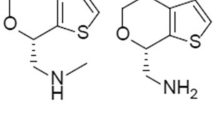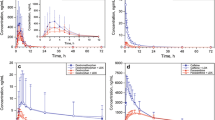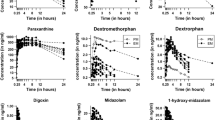Abstract
Objective
To determine the multiple dose pharmacokinetics of a new extended release (ER) capsule formulation of tolterodine, compared with the existing immediate release (IR) tablet, in healthy volunteers.
Design
Nonblind, randomised, 2-way crossover trial.
Participants
19 healthy volunteers (7 females, 12 males), mean age 33 years (range 18 to 55 years). Prior to the study, all volunteers were classified as either extensive or poor metabolisers by cytochrome P450 2D6 genotyping.
Methods
Volunteers received tolterodine ER 4mg once daily or tolterodine IR 2mg twice daily for 6 days (all doses given as the L-tartrate salt). A washout period of 7 days separated the 2 treatments. Serum concentrations of tolterodine, its active 5-hydroxymethyl metabolite (5-HM) and the active moiety (extensive metabolisers: sum of unbound tolterodine + 5-HM; poor metabolisers: unbound tolterodine) were measured for up to 48 hours post-dose on day 6 (steady state). Tolerability was also determined.
Results
17 volunteers (13 extensive metabolisers, 4 poor metabolisers) completed the study and were evaluable for both treatment periods. The 90% confidence interval for the geometric mean ratio of area under the serum concentration-time curve to 24 hours (AUC24) of the active moiety, for all volunteers combined, indicated equivalence for the 2 formulations. Pooled analysis also demonstrated that the peak serum concentration (Cmax) of the active moiety following administration of tolterodine ER was around 75% of that observed for the IR tablet, whereas the trough concentration was around 1.5-fold higher. Overall, the pharmacokinetics of tolterodine (irrespective of genotype) and 5-HM (extensive metabolisers only) were consistent with sustained drug release over 24 hours. Tolterodine ER was well tolerated.
Conclusions
The new once daily ER formulation of tolterodine 4mg shows pharmacokinetic equivalence (AUC24) to the existing IR tablet given at a dose of 2mg twice daily. Findings of lower Cmax for tolterodine ER may explain the significantly lower rate of dry mouth subsequently observed in patients with overactive bladder.




Similar content being viewed by others
References
Appell RA. Clinical efficacy and safety of tolterodine in the treatment of overactive bladder: a pooled analysis. Urology 1997; 50 (6ASuppl.): 90–6
Abrams P, Freeman R, Anderström C, et al. Tolterodine, a new antimuscarinic agent: as effective but better tolerated than oxybutynin in patients with an overactive bladder. Br J Urol 1998; 81: 801–10
Drutz H, Appell RA, Gleason D, et al. Clinical efficacy and safety of tolterodine compared to oxybutynin and placebo in patients with overactive bladder. Int Urogynecol J Pelvic Floor Dysfunct 1999; 10: 283–9
Chancellor M, Freedman S, Mitcheson HD, et al. Tolterodine, an effective and well tolerated treatment for urge incontinence and other overactive bladder symptoms. Clin Drug Invest 2000; 19: 83–91
Nilvebrant L. The mechanism of action of tolterodine. Rev Contemp Pharmacother 2000; 11: 13–27
Postlind H, Danielson Å, Lindgren A, et al. Tolterodine, a new muscarinic receptor antagonist, is metabolized by cytochromes P450 2D6 and 3A in human liver microsomes. Drug Metab Dispos 1998; 26: 289–93
Mahgoub A, Idle JR, Dring LG, et al. Polymorphic hydroxylation of debrisoquine in man. Lancet 1977; II: 584–6
Alván G, Bechtel P, Iselius L, et al. Hydroxylation polymorphisms of debrisoquine and mephenytoin in European populations. Eur J Clin Pharmacol 1990; 39: 533–7
Brynne N, Dalén P, Alván G, et al. Influence of CYP2D6 polymorphism on the pharmacokinetics and pharmacodynamics of tolterodine. Clin Pharmacol Ther 1998; 63: 529–39
Larsson G, Hallén B, Nilvebrant L. Tolterodine in the treatment of overactive bladder: analysis of the pooled phase II efficacy and safety data. Urology 1999; 53: 990–8
Påhlman I, Gozzi P. Serum protein binding of tolterodine and its major metabolites in humans and several animal species. Biopharm Drug Dispos 1999; 20: 91–9
Physicians’ desk reference. 54th ed. Montvale (NJ): Medical Economics Co. Inc., 2000: 2439-41
Wein AJ, Abrams P, Appell R, et al. Tolterodine is effective and well tolerated during long-term use in patients with overactive bladder [abstract]. J Urol 1999; 161 Suppl.: 35
Appell RA, Abrams P, Drutz HP, et al. Treatment of overactive bladder: long-term tolerability and efficacy of tolterodine. World J Urol. In press
Olsson B, Szamosi J. Food does not influence the pharmacokinetics of a new extended release formulation of tolterodine for once daily treatment of patients with overactive bladder. Clin Pharmacokinet 2001; 40: 135–43
Pharmacia Corporation. Influence of tolterodine on the pharmacokinetics of Neovletta®, an oral contraceptive. An open, randomized, multiple-dose cross-over study in healthy volunteers [Document no. 9600483]. Stockholm: Pharmacia Corp. (Data on file)
Dahl ML, Johansson I, Palmertz MP, et al. Analysis of the CYP2D6 gene in relation to debrisoquin and desipramine hydroxylation in a Swedish population. Clin Pharmacol Ther 1992; 51: 12–7
Palmér L, Andersson L, Andersson T, et al. Determination of tolterodine and the 5-hydroxymethyl metabolite in plasma, serum and urine using gas chromatography-mass spectrometry. J Pharm Biomed Analysis 1997; 16: 155–65
Shiga T, Fujimura A, Tateishi T, et al. Differences of chronopharmacokinetic profiles between Propranolol and atenolol in hypertensive subjects. J Clin Pharmacol 1993; 33: 756–61
Jamali F, Thomson AB, Kirdeikis P, et al. Diurnal variation in the pharmacokinetics of nizatidine in healthy volunteers and in patients with peptic ulcer disease. J Clin Pharmacol 1995; 35: 1071–5
Hsu A, Granneman GR, Witt G, et al. Multiple-dose pharmacokinetics of ritonavir in human immunodeficiency virus-infected subjects. Antimicrob Agents Chemother 1997; 41: 898–905
Min DI, Chen H-Y, Lee M-K, et al. Time-dependent disposition of tacrolimus and its effect on endothelin-1 in liver allograft recipients. Pharmacotherapy 1997; 17: 457–63
Gupta SK, Sathyan G. Pharmacokinetics of an oral once-a-day controlled-release oxybutynin formulation compared with immediate-release oxybutynin. J Clin Pharmacol 1999; 39: 289–96
Goo RH, Moore JG, Greenberg E, et al. Circadian variation in gastric emptying of meals in humans. Gastroenterology 1987; 93:515–18
Olsson B, Brynne N, Johansson C, et al. Food increases the bioavailability of tolterodine but not effective exposure. J Clin Pharmacol 2001; 41: 1–7
Van Kerrebroeck PEVA, Kreder K, Jonas U, et al. Tolterodine once-daily: superior efficacy and tolerability in the treatment of overactive bladder. Urology 2001; 57: 414–21
Acknowledgements
This study was supported by Pharmacia Corporation, of whom both authors were employees at the time the study was conducted. The authors wish to thank Nkechi Azie, Joy Wisser and Sharyn Cugnetti at the Pharmacia Clinical Research Unit, Kalamazoo, Michigan, USA, for the clinical conduct of the study.
Author information
Authors and Affiliations
Corresponding author
Rights and permissions
About this article
Cite this article
Olsson, B., Szamosi, J. Multiple Dose Pharmacokinetics of a New Once Daily Extended Release Tolterodine Formulation Versus Immediate Release Tolterodine. Clin Pharmacokinet 40, 227–235 (2001). https://doi.org/10.2165/00003088-200140030-00006
Published:
Issue Date:
DOI: https://doi.org/10.2165/00003088-200140030-00006




